mobile View, to the German Version tap the flag


- Autonomous Region of Spain
- Kingdom until 1833
- own names:
– Spanish: Aragón
– Aragonese: Aragón
– Catalan: Aragón
• Flag
• Historical and other Flags
• Meaning/Origin of the Flag
• Coat of Arms
• Historical Coats of Arms
• Meaning/Origin of the Coat of Arms
• Map of the autonomous regions of Spain
• Map of the historical Kingdoms on the Iberian Peninsula
• Numbers and Facts
• History
• Origin of the Country's Name
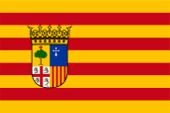
Flag of Aragon,
ratio = 2:3,
Source, by: Flags of the World






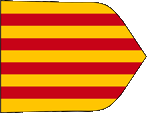
1150–1516,
Flag of Aragon,
Source, by: Wikipedia (EN)



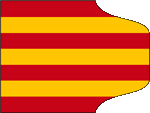
1263–1516, (?)
Naval flag of Aragon,
Source, by: Flags of the World



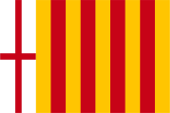
1977–1978,
unofficial flag of Aragon,
ratio = 2:3,
Source, by: World Statesmen



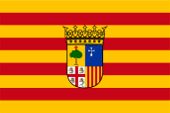
1978–1984,
Flag of Aragon,
ratio = 2:3,
Source, by: Wikipedia (ES)




The today's flag of Aragon was introduced on 28th of June in 1984. It shows four horizontal red stripes on a golden background and the coat of arms of Aragon with the Aragonese crown in the centre. The flag with its red and golden stripes goes back to the historical heraldry of Aragon and Catalonia. The escutcheon dates back to the 15th century. Under the government of General Franco (1936-1975), all regional flags were banned. After Franco's death, the regional flags were reintroduced or new ones were created. Aragon adopted a flag with four red vertical stripes on a golden background in 1977, with an additional white field on the pole with a red cross, albeit unofficially at first, as Aragon did not have autonomous status until 1982. Already in 1978, a new flag followed, which already resembled the present one, the coat of arms appearing in the middle of the flag. The oldest flags of Aragon were typical armorial flags, created by rotating and attaching the coat of arms image to a flagpole. The naval flag used by Aragon from the 13th century onwards is remarkable because it shows three golden bars on a red background. Remarkable is a naval flag allegedly used by Aragon from the 13th century onwards. It shows three golden bars on a red background. After all, it could be an observation error or an error caused by incorrect marking. And standards like today did not exist back then.
Source:
Wikipedia (ES),
Flags of the World,
Volker Preuß


since 1921,
Coat of arms of Aragon,
Source, by:
Wikipedia (ES)


11th/12th century,
legendary coat of arms of Aragon,
Source, by:
Wikipedia (DE)

Coat of arms with the Cross of Alcoraz,
Source, by:
Wikipedia (DE)

12th century,
Coat of arms of the County of Barcelona,
Source, by:
Wikipedia (DE)

from 1150,
Coat of arms of the united crown of Aragon,
Source, by:
Wikipedia (DE)

The current coat of arms of Aragon was introduced on 16th of April in 1984, after having been created in 1921. It goes back to a coat of arms of the Kingdom of Aragón from the 15th century. The Spanish Kingdom of Aragón came into being when King Sancho III of Navarre (Sancho the Great) divided his kingdom among his sons in 1035. His son Ramiro received the old county of Aragón and became the first king of Aragón as Ramiro I. No coats of arms have survived from this early period. However, Ramiro is credited with a blue coat of arms with the cross of Íñigo Arista, which has survived to this day as part of the country's heraldry, as has the cross of Alcoraz, which goes back to King Peter I. This coat of arms showed a red St George's cross on silver and in each of the four fields a so-called Moor's head with an eye-patch. The Moor's heads are the heads of four Moorish kings who were defeated and beheaded by King Peter I in the Battle of Alcoraz in 1096. The red cross symbolised the Christian faith. Before his death in 1137, King Ramiro II of Aragon appointed his newborn daughter Petronella as heiress, who married Raimund Berengar IV, Count of Barcelona (Catalonia) in 1150. Thus was born the united Crown of Aragon under the arms of Raimund Berengar IV, which was extended to include the Balearic Islands in 1228–1232 and the county of Valencia in 1238. This coat of arms showed four vertical red bars on gold. It goes back to a coat of arms that was supposedly given to Wilfried the Hairy, then Count of Barcelona, around 875 by the West Frankish King Charles the Bald, because he had shown bravery in the fight against the Moors (Arabs). According to legend, it was created when a fighter drew the four bleeding fingers of his hand through the count's coat of arms, which had been in use until then. The colours red and gold, however, supposedly go back to the influence of the Pope, because the old kingdom of Aragon and the county of Barcelona were fiefdoms of the Holy See. Red and gold are the colours of the city of Rome. After the union of Aragon and Catalonia, the heraldry of Catalonia was adopted for the whole country. However, when Aragon took over Sardinia and briefly Corsica, the cross of Alcoraz or one of the Moor's heads were adopted as local heraldry.
Source: Wikipedia (ES),
Wikipedia (DE),
Volker Preuß

The autonomous Regions of Spain:
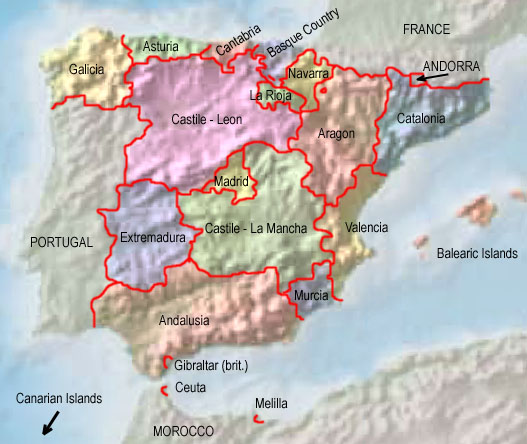
Source: Freeware, University of Texas Libraries, modyfied by: Volker Preuß

Map of the historical Kingdoms on the Iberian Peninsul (ca. 1220):
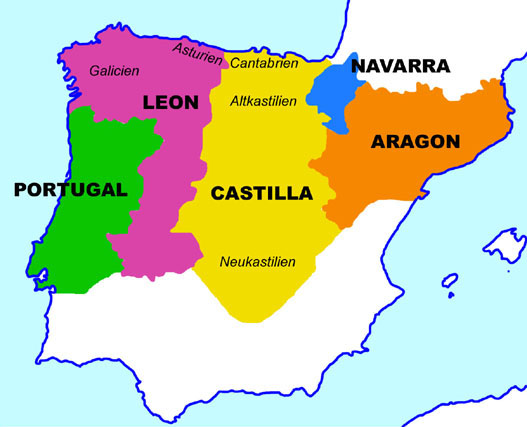
Map: Volker Preuß

Area: 18.424 square miles
Inhabitants: 1.326.233 (2022), thereof 95% Aragonese Castiles, 4% Catalans
Density of Population: 72 inh./sq.mi.
Capital: Saragossa (Zaragoza), 673.010 inh. (2022)
official Language: Spanish (Castilian)
other Languages: Aragonese, Catalan
Currency: Spanish (Euro) currency
Time Zone: GMT + 1 h
Source: Wikipedia (EN)

early ages · settlement by Iberians
ca. 600 B.C. · immigration of Celts, mix with the Iberians, evolution of the Celtiberians
218–201 B.C. · Second Punic War, the Roman Empire acquires the possessions of Carthago in Iberia, subjugation of whole Iberia until the year 19 B.C., Roman settlement, romanization, the today’s Aragon comes to the Roman province of Hispania Tarraconensis
ca. 400 A.D. · Great Transmigration (Migration Period), immigration of Alans, teutonic Suebs and Western Goth
415 · to the Empire of the Western Goth
711–714 · annihilation of the Empire of the Western Goth by from northern Africa coming Arabs
714 · the Arabs conquer Aragon
778 · the Frankish Empire under Carl the Great conquers Aragon, establishment of the Spanish Mark in the foreland of the Pyrenees Mountains, but defeat against the Basques in the Valley of Ronceval
795–812 · re-establishment of the Spanish Mark by Carl the Great and his son Ludvig the Pious
ca.820–ca.880 · crisis of the Frankish Empire after the death of Carl the Great, sharing out of the empire, succession quarrels, the Frankish margrave become banished in the Spanish Mark and were substituted by elected local dynasties, but not in Aragon, there was elected Count Azenar to the Count of Aragon, the son of Eudo Duke of Aquitania, which made itself independent from the Frankish Empire
905–925 · expansion of the neighbouring Kingdom of Navarra
ca.1000 · vanish of the Counts of Aragon, the heritage comes to the Kingdom of Navarra
1001–1035 · times of the rule of Sancho III. of Navarra (the Elder, the Great), after his death the kingdom becomes shared under his four sons: Garcia becomes king of Navarra, Ferdinand becomes king of Castile, Ramiro becomes king of Aragonia, Gonzales becomes king of Ribagorza-Sobrarbe
ca.1040–1060 · Ramiro I. of Aragon acquires Ribagorza and Sobrarbe, triumphs severally over the Muslims and becomes crowned to king
1063–1104 · times of the rule of the kings Sancho Ramirez and Pedro, liberation of further territories from the Muslims
1104–1134 · times of the rule of king Alfons I.
1109 · Alfons I. marrys a daughter of king Alfons VI. of Castile (unification of Aragon and Castile)
1118 · Alfons I., king of Aragon, conquers Saragossa (Zaragoza) and makes it to capital, liberation of Tarragona from the Muslims
1134 · death of king Alfons I., in his testament he bequeathes his empire to the clerical knight orders of the reconquista, but his last will becomes ignored by the estates of Aragon, the brother of Alfons I., becomes elected to king as Ramiro II., Castile becomes independent again
1137 · Ramiro II., King of Aragon, engages his daughter Pedronella with Raimund Berengar IV., the Count of Barcelona (Catalonia)
1150 · wedding of Pedronella and Raimund Berengar
1162 · Alfons II., son of Raimund Berengar becomes Count of Barcelona
1163 · Alfons II. becomes king of Aragon (in this way unification of Aragon and Catalonia)
1172 · Aragon acquires the County of Roussillon and the Cerdagne (momentary even Montpellier and Carcassonne)
1196–1213 · times of the rule of king Pedro II.
1213–1276 · times of the rule of king Jakob I.
1228–1232 · Aragon acquires the Balearic Islands
1238 · liberation of Valencia from the Muslims
1248 · liberation of Alicante from the Muslims
1276–1285 · times of the rule of king Peter III.
1282 · Aragon acquires Sicily Island („Sicilian Vespers”, expulsion of the house of Anjou out of Palermo), war with France
1283 · increase of tax, the estates of Aragon compel from the king the General Privilege of Saragossa
1285–1291 · times of the rule of king Alfons III., wars with Castile and France, the estates become stronger
1291–1327 · times of the rule of king Jacob II., the brother of Alfons III.
1326 · Aragon acquires Sardinia Island
1319 · the non-divisibility of the empire (sharing out because of heritage) becomes fixed by law, furthermore own corporate assemblys (Cortes) in Catalonia and Valencia
1327–1336 · times of the rule of king Alfons IV., the son of Jacob II., wars in alliance with Castile against Genua and the Arabs
1336–1387 · times of the rule of king Peter IV., the son of Alfons IV., end of the war against Genua, partial loss of Sardinia, war against Castile, brother war against the other sons of Alfons IV., the estates become stronger
1387–1395 · times of the rule of king Johann, the son of Peter IV., loss of Sardinia
1410 · death of King Martin, the brother of Johann, vanish of the dynasty of Ramiro of Navarra
1410–1412 · throne quarrels, by arbitrage becomes Ferdinand I. of Castile – a nephew of king Johann - king of Aragon
1412–1416 · times of the rule of king Ferdinand I.
1416–1458 · times of the rule of king Alfons V., the son of Ferdinand I., regency by his consort Maria of Castile and his brother Johann, Alfons V. conquers the Kingdom of Naples (1442) from the house of Anjou and unites Naples and Sicily with Aragon, conflicts with France
1458 · death of Alfons V., his son Ferdinand becomes king in Naples, his brother Johann II. becomes king of Aragon (married with Blanca of Navarra, in this way even king of Navarra, ceding of the Roussillon to France
1479 · death of king Johann II., successor is his son Ferdinand II.
1469 · marriage of Isabella I., Queen of Castile-Leon and Ferdinand II., the Prince and Throne-Successor of Aragon
1479 · coronation of Ferdinand II. and Isabella I. to kings of Spain
1516 · official unification of Aragon and Castile, but Aragon withholds important privileges
1609 · king Philipp III. of Spain banishes the last Muslims (Moresques) out of the country
1701–1714 · Spanish succession war, Aragon positiones itself at the side of Austria, after the defeat loss of the privileges, end of the independent kingship of the United Crown of Aragon, Catalonia, the Balearic Islands and Valencia become outsourced, Aragon (in its today’s borders) and Valencia withhold nominally the title of a kingdom, Catalonia becomes nominally the Principality of Barcelona
1808–1813 · Aragon is occupied by French troops
1833 · the until that point in time in Spain existing partial kingdoms and regions become divided in provinces, the Kingdom of Atagon in the provinces of Huesca, Zaragoza and Teruel
1936–1939 · Spanish Civil War, Aragon fights until 1939 partially on the side of the socialistic governmental troops, in Catalonia exists an "Anarchist Republic" until the conquest by the socialistic governmental troops
1978 · temporary autonomy statute for Aragon
10th of August 1982 · (by other sources 16th of August 1982) Aragon gets the statute of autonomy within Spain (by summary of the provinces of Huesca, Zaragoza and Teruel), establishment of the "Autonomous Community of Aragon"
7th of May 1992 · revision of the autonomy statute, enlargement of the autonomy rights of Aragon
Source: Wikipedia (ES),
World Statesmen,
RetroBib Retrobibliothek,
Volker Preuß

The name "Aragon" goes back to the River "Aragón", a affluent of Ebro River. Probably the Western Goth gave the river its name, because in "Aragón" is hidden the syllable "ah" resp. "aha", the ancient teutonic word for "water".
Source: Handbuch der geographischen Namen


![]()























